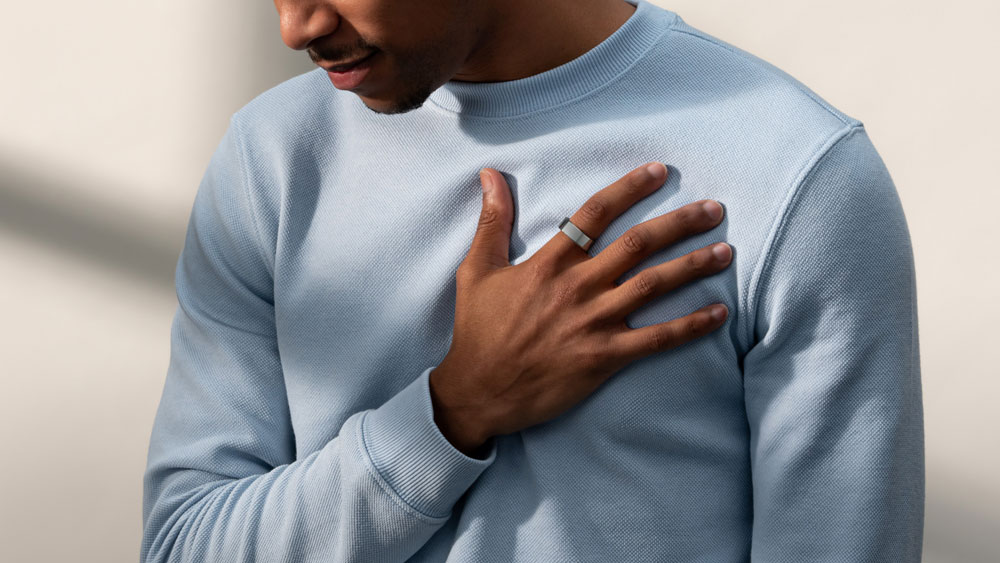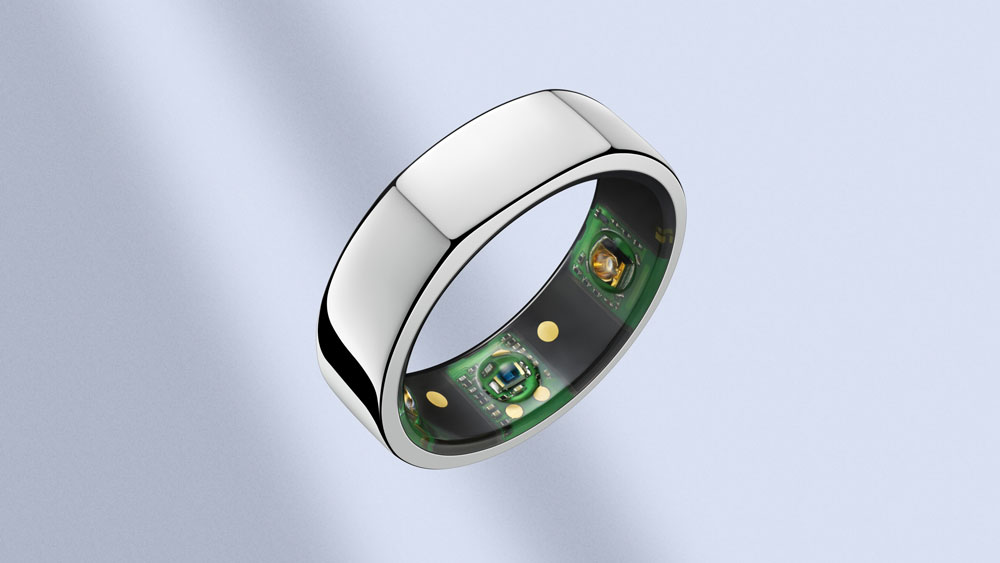You can trust Coach
Last year, in the face of the surging pandemic, the American NBA basketball league formed a bubble at Disney World, where 22 teams finished the regular season and the play-offs without a single case of COVID-19.
One of the tools used to maintain the integrity of the bubble was the Oura Ring. The sensors on board this smart ring track your resting heart rate, heart rate variability (HRV) and body temperature from your finger, and use the data to spot if your body is succumbing to illness before more obvious symptoms occur.
However, while that is undoubtedly an interesting area, it’s not how the Oura Ring is pitched to consumers. It’s sold as an accurate sleep tracker that then assesses your “readiness”, an overall snapshot of your health, each day.
Though it does keep tabs on your activity levels, the Oura Ring is not a fitness tracker in the traditional sense, which makes it more of a niche device. However, after wearing it for a month, I can say the Oura Ring absolutely dominates the niche it’s in, doing a terrific job of tracking your sleep and providing sound insight into your day-to-day recovery.
Design
The Oura Ring is made from titanium with a coating of diamond-like carbon. It’s lightweight, waterproof and durable, and comes in a couple of styles – one with a flat top and one with a point. There are also four colour options, and there’s even a version with actual diamonds on the top. The Oura Ring costs from $299 (around £255) to $999 (£850) depending on the materials.
On the inside of the ring are three protruding sensors, which need to be in contact with the skin, especially at night, to get accurate data. Getting the fit right is tricky with rings, so Oura first sends a sizing kit. It’s worth investing some time in this, because the size of your finger changes a surprising amount throughout the day. One ring that was comfortable for me all day became pretty much stuck in place overnight.
I have big knuckles and small fingers, so getting a close fit was hard. In the end I picked a size that I hoped would work on a couple of different fingers, and rather than my ring finger my Oura has ended up on my index for a more reliable fit. I’ve never worn any rings aside from my wedding band, but the Oura was not at all uncomfortable.
Sign up for workout ideas, training advice, reviews of the latest gear and more.
The ring packs a lot of sensors into its small frame: two infrared LED sensors to track heart rate and breathing, an accelerometer to monitor movement, and a negative thermal coefficient body temperature sensor.
The advantage of a ring over a wrist wearable is accuracy, especially at night. The Oura Ring is on a different level from any other sleep tracker I’ve tested for accuracy. Helpfully my toddler was going through a sleep regression during my testing, so the Oura’s uncanny ability to pinpoint periods awake and nail the times I fell asleep and woke up really stood out, especially when the other sports watches and the Whoop band I was also testing at the time often missed these things.
I generally got around six days of use out of the ring before having to charge it, and the app will notify you when you need to pop it on its wireless charging station, ensuring you do so before going to bed so you don’t miss a night of sleep data.

Activity Tracking And The Readiness Score
All the info the Oura Ring records is interpreted by the app and presented to you in an easy-to-understand way. The app is broken up into three areas: activity, sleep and readiness.
Your activity – such as steps, inactive time and calories burned – is tracked during the day and you are given an active calorie target to hit based on your overall readiness. The activity you do feeds into your readiness score the next day too, and the app connects with the Apple Health and Google Fit apps so workouts recorded there are synced with the Oura app.
The activity area of the app is basic compared with the sleep and readiness sections, and you could just wear the Oura Ring at night to get the core benefits if you wanted.
The daily readiness score is out of 100 and indicates how prepared your body is for an active day. The score is based on your previous night’s resting heart rate, HRV, how well you’ve slept and your body temperature, all of which are compared with your baselines. You need to wear the Oura Ring for a couple of weeks to set these baselines, and after that it will increase in accuracy over time as it gets to know you better.
Your readiness score features on the app’s home screen along with a short piece of advice on how to approach the day – you might be advised to take a day to recover if your readiness is low, or to “go get ’em” if you score highly. The readiness tab in the app offers more detailed stats and graphs, plus simple explanations of what’s being recorded and why it’s important.
It’s very well done, and early on I spent a lot of time familiarising myself with each piece of data. Over time you might tend to stick with the front page scores, but there’s always more detail there if you want it. The app also does a good job of not terrifying you when your readiness score is low too, and provides advice on how to improve your score the following day. This is pretty basic stuff like taking time to recover and prioritising sleep, but from my experience when a device is accurate like the Oura Ring, you are far more likely to accept that advice and then enjoy watching your readiness score rise.

Sleep Tracking
The Oura Ring provides the best sleep tracking I’ve seen on a wearable. In the morning you get a sleep score on the app home screen, rated out of 100, plus many more details on your night in the sleep tab.
There are three things that make the Oura’s sleep tracking stand out. The first is the accuracy of the data it collects across the standard sleep-tracking stats, like HRV, resting heart rate, overall time asleep, time spent in light, deep and REM sleep, and nighttime movement. The second is the inclusion of uncommon measures, like latency – the time taken to fall asleep – and body temperature.
Finally, there are clear explanations of every stat in the app and the data is shown against your own baselines. If you keep getting red-flagged on latency, for example, you can see some advice on how to improve it.
Granted, none of the advice is revelatory, but I found it more compelling because of the accuracy of the Oura. Lots of fitness trackers will supply similar sleep advice, but if you’re not sure that advice is relevant because the data is demonstrably wrong, then it loses its appeal. This was the case with the Whoop band, for example: I found it was consistently inaccurate in picking up the amount of strain I put my body under in the day, so I ignored its advice on how to improve things.
The Oura is not flawless on the accuracy front, though, and my HRV and resting heart rate graphs would often have gaps where the data wasn’t picked up overnight. This was generally because of movement – you can see your nighttime movement graphed as well – and sometimes I’d lose pretty significant chunks of my night. However, while a worry early on, these gaps don’t seem to have had an impact on the usefulness and accuracy of my overall sleep and readiness scores.
While wearing the Oura Ring, I made a deliberate effort to improve my sleep, acts of toddler sabotage notwithstanding. As a committed runner I’ve started to make more of an effort to get enough sleep before key training sessions and races in particular. When you’re rewarded for that effort with an improved sleep score and a high readiness rating, and you’re confident those stats are based on good data because you noticeably feel better and more energised, the Oura Ring really starts to show its worth.
Verdict
The accuracy of the Oura Ring means it provides genuinely useful advice that can help to shape your sleep and activity. It is unrivalled in what it does, with similar options like Whoop falling short purely by failing to match the Oura’s accuracy.
It’s also an attractive, comfortable device to wear – and even if you don’t like the look, you can get most of the features the Oura offers by just wearing it at night.
It is expensive, though, especially as you’re not getting sports tracking or other features offered by watches and bands these days, such as smart notifications, NFC payments or even a screen. Those devices are clearly better all-rounders, and some offer good insight into sleep and recovery, with Fitbit and Polar the stand-outs on those fronts. Those devices fall short of the accuracy and detail the Oura provides on sleep and readiness, but offer so much more in other areas that many people will be better off with a tracker than the Oura Ring. Combining the Oura Ring with a sports tracker would work well, but obviously that’s quite an expensive route to go down.
The advice you get from the Oura will benefit almost anyone, from people just looking to log 150 minutes of moderate activity a week to elite athletes trying to plan their training for when their body is ready to perform at its best. Whether that’s worth the investment on a device that doesn’t offer many of the other benefits you get from a fitness tracker depends on how closely you’ll follow the Oura’s advice.

Nick Harris-Fry is a journalist who has been covering health and fitness since 2015. Nick is an avid runner, covering 70-110km a week, which gives him ample opportunity to test a wide range of running shoes and running gear. He is also the chief tester for fitness trackers and running watches, treadmills and exercise bikes, and workout headphones.

